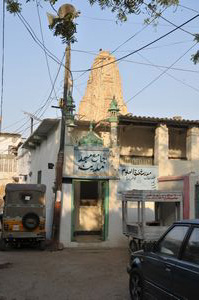Malir Temple, Karachi
Written in English on a small plaque on the right side of the main entrance is the history of the compound itself. The plaque states that it was built as a sanatorium on Dec 10, 1914, by “Dedhar Pragji, in the memory of Tekar Lakshmidass and Shivaji Kanji Pragji Somaya”. The same is stated on the left of the entrance in Hindi. A temple inside the sanatorium was built before that, added historian and writer Gul Hassan Kalmati, which was a Shiv Mandir.
Also associated with the Indigenous Alliance protesting the recent construction of the shops, Kalmati said: “Hindus never lived inside the sanatorium; they only visited the temple during religious ceremonies. Later, after the partition, a group of migrants were provided shelter in the sanatorium with the promise of being provided an alternative compound. But since that never happened, they ended up living here.”
Testifying to that, Ahmed said that his family moved in 40 years ago when he was just five. “We had nowhere to go at the time as our family had sold everything in India in order to move to Pakistan. We have a mosque and a temple inside the compound,” he added.
But the temple is sealed. This happened after the demolition of Babri Masjid in Ayodhya in 1992.
One of the residents, Mohammad Zohaib, says: “A group of men barged into the compound and attacked the mandir the day the mosque was attacked in India. Since then, the mandir is sealed and locked by the Auqaf department (which takes care of the shrines and mosques).”
Standing in the centre of the criss-crossing lanes of the compound, the temple is only visible through its elegant upper structure. The lower part is covered from all four sides by the surrounding two-room houses.
Kalmati believed that incidents like Ayodhya “provide best opportunities to the land grabbers in the city. For them, it is an opportunity to take over a heritage site and build something else in its place”.
Mohammad Zubair, one of the shopkeepers, said that he paid Rs400 rent for the shop, which will soon be a milk shop, on land he said was owned by the Auqaf department. “My father, Mohammad Nawaz, owns the place and we are building this shop legally,” is all that Zubair said when asked about the ownership of the shop. The residents say that the construction began in November and that, so far, no one from the Auqaf department came to stop the construction.
However, Kalmati questioned the claims of the residents and of those constructing the shops and said that the Auqaf department was probably not the right authority to speak on the issue. “The land might be under the ownership of the culture department or the Evacuee Trust Property Board (ETPB). We are in the process of approaching them and as soon as we get a response from them we’d know exactly how to stop the construction,” he added.
Source: Published in Dawn, January 4th, 2017 | Photographs: EFT
Copyright © 2019 · All Rights Reserved · Endowment Fund Trust



